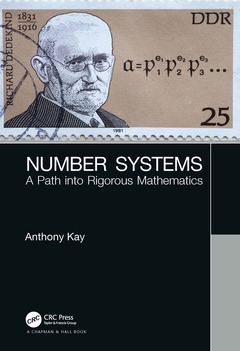Number Systems A Path into Rigorous Mathematics
Auteur : Kay Anthony

Number Systems: A Path into Rigorous Mathematics aims to introduce number systems to an undergraduate audience in a way that emphasises the importance of rigour, and with a focus on providing detailed but accessible explanations of theorems and their proofs. The book continually seeks to build upon students' intuitive ideas of how numbers and arithmetic work, and to guide them towards the means to embed this natural understanding into a more structured framework of understanding.
The author?s motivation for writing this book is that most previous texts, which have complete coverage of the subject, have not provided the level of explanation needed for first-year students. On the other hand, those that do give good explanations tend to focus broadly on Foundations or Analysis and provide incomplete coverage of Number Systems.
Features
- Approachable for students who have not yet studied mathematics beyond school
- Does not merely present definitions, theorems and proofs, but also motivates them in terms of intuitive knowledge and discusses methods of proof
- Draws attention to connections with other areas of mathematics
- Plenty of exercises for students, both straightforward problems and more in-depth investigations
- Introduces many concepts that are required in more advanced topics in mathematics.
1. Introduction: The Purpose of this Book. 1.1. A Very Brief Historical Context. 1.2. The Axiomatic Method. 1.3. The Place of Number Systems within Mathematics. 1.4. Mathematical Writing, Notation and Terminology. 1.5. Logic and Methods of Proof. 2. Sets and Relations. 2.1. Sets. 2.2. Relations between Sets. 2.3. Relations on a Set. 3. Natural Number, N. 3.1. Peano's Axioms. 3.2. Addition of Natural Numbers. 3.3. Multiplication of Natural Numbers. 3.4. Exponentiation (Powers) of Natural Numbers. 3.5. Order in the Natural Numbers. 3.6. Bounded Sets in N. 3.7. Cardinality, Finite and Infinite Sets. 3.8. Subtraction: the Inverse of Addition. 4. Integers, Z. 4.1. Definition of the Integers. 4.2. Arithmetic on Z. 4.3. Algebraic Structure of Z. 4.4. Order in Z. 4.5 Finite, Infinite and Bounded Sets in Z. 5. Foundations of Number Theory. 5.1. Integer Division. 5.2. Expressing Integers in any Base. 5.3. Prime Numbers and Prime Factorisation. 5.4. Congruence. 5.5. Modular Arithmetic. 5.6. Zd as an Algebraic Structure. 6. Rational Numbers, Q. 6.1 Definition of the Rationals. 6.2. Addition and Multiplication on Q. 6.3. Countability of Q. 6.4. Exponentiation and its Inverse(s) on Q. 6.5. Order in Q. 6.6. Bounded Sets in Q. 6.7. Expressing Rational Numbers in any Base. 6.8. Sequences and Series. 7. Real Numbers, R. 7.1. The Requirements for our Next Number System. 7.2. Dedekind Cuts. 7.3. Order and Bounded Sets in R. 7.4 Addition in R. 7.5. Multiplication in R. 7.6. Exponentiation in R. 7.7. Expressing Real Numbers in any Base. 7.8. Cardinality of R. 7.9. Algebraic and Transcendental Numbers. 8. Quadratic Extensions I: General Concepts and Extensions of Z and Q. 8.1. General Concepts of Quadratic Extensions. 8.2. Introduction to Quadratic Rings: Extensions of Z. 8.3. Units in Z[√k]. 8.4. Primes in Z[√k]. 8.5. Prime Factorisation in Z[√k. 8.6. Quadratic Fields: Extensions of Q. 8.7. Norm-Euclidean Rings and Unique Prime Factorisation. 9. Quadratic Extensions II: Complex Numbers, C. 9.1. Complex Numbers as a Quadratic Extension. 9.2. Exponentiation by Real Powers in C: a First Approach. Geometry of C; the Principal Value of the Argument, and the Number π. 9.4. Use of the Argument to Define Real Powers in C. 9.5. Exponentiation by Complex Powers; the Number e. 9.6. The Fundamental Theorem of Algebra. 9.7. Cardinality of C. 10. Yet More Number Systems. 10.1. Constructible Numbers. 10.2. Hypercomplex Numbers. 11. Where Do We Go From Here? 11.1. Number Theory and Abstract Algebra. 11.2. Analysis. A. How to Read Proofs: The `Self-Explanation' Strategy.
Anthony Kay was a Lecturer in Mathematical Sciences at Loughborough University for 32 years up to his retirement in 2020. Although his research has been in applications of mathematics, he has taught a wide range of topics in pure and applied mathematics to students at all levels, from first year to postgraduate.
Date de parution : 09-2021
17.8x25.4 cm
Date de parution : 09-2021
17.8x25.4 cm
Thèmes de Number Systems :
Mots-clés :
Number Systems; Number Theory; Binary Operations; Introductory Mathematics; Cayley Dickson Algebras; Proofs; Natural Number; Real Numbers; Additive Inverse; Integers; Abelian Group; Rational Numbers; Inductive Hypothesis; Algebraic Structure; Hypercomplex Numbers; Unique Member; Inverse Element; Commutative Ring; Quadratic Extension; Ordered Rings; Mathematical Expressions; Order Isomorphism; Greatest Member; Negative Integers; Positive Integers; Algebraic Number Theory; Non-empty Proper Subset; Inverse Operation; Equivalence Relation; Axiomatic Method



